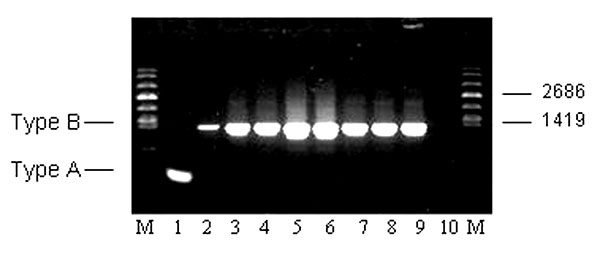Volume 10, Number 3—March 2004
Research
Laboratory Analysis of Tularemia in Wild-Trapped, Commercially Traded Prairie Dogs, Texas, 2002
Figure 1

Figure 1. Molecular subtyping of representative Francisella tularensis isolates from Groups A, B, C, E, and F prairie dogs. The expected size PCR fragments for F. tularensis subsp. tularensis (Type A) and holarctica (Type B) are shown in lanes 1 and 2, respectively. Subtyping results for the five groups (A, B, C, E, F) are shown in lanes 3–9. Lane 3: TX021935 (A); lane 4: TX022151 (A); lane 5: TX022537 (B); lane 6: TX022592 (B); lane 7: TX022799 (C); lane 8: TX022107 (E); lane 9: CZ024233 (F). Lane 10: no DNA template control. Lane M: molecular weight markers.
Page created: February 08, 2011
Page updated: February 08, 2011
Page reviewed: February 08, 2011
The conclusions, findings, and opinions expressed by authors contributing to this journal do not necessarily reflect the official position of the U.S. Department of Health and Human Services, the Public Health Service, the Centers for Disease Control and Prevention, or the authors' affiliated institutions. Use of trade names is for identification only and does not imply endorsement by any of the groups named above.